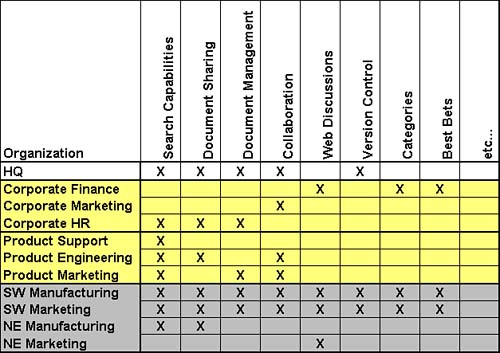| While the organization supporting a Microsoft SharePoint Portal implementation must possess a robust set of capabilities and regularly perform and test a number of mission-critical services, additional requirements regarding enterprise-wide implementations are noted in the following sections. The technical support organization must be ultra flexible. That is, the organization initially crafted to support the Portal deployment will not have their arms around the scope of the project until deep into the business requirements analysis and subsequent architecture process. It is not uncommon, then, to incrementally add technical personnel to the technical support organization with "new" skillsets specific to areas like high availability or storage-area -network design (for example) halfway into the architecture process. The technical support organization will probably be lacking in end-to-end content management experience. The quickest and most effective way to jump-start this shortcoming is by leveraging a SharePoint- experienced consultant or consulting organization, as mentioned previously. Then, by carefully managing knowledge transfer between the consultant and the other team members , and taking advantage of formal and supplementary training opportunities, the technical support organization will mature into a capable SPS-support team. Security will play a bigger role, and therefore present a more complex challenge, in an enterprise-wide Portal implementation. One common way to address this challenge is by creating a combined business unit/IT subgroup focused on security considerations. Change management will be the wax that holds the entire production solution, and indeed system landscape, together. Without sound yet flexible processes for introducing change into the production environment, a complex business-driven IT solution like SharePoint Portal Server will implode within months of go-live . People committed to all phases of the project will be necessary. An enterprise-wide Portal deployment will exercise creative minds, and demand creative solutions and implementation specialists ”though perhaps not from an IT perspective so much as from a business collaboration and data management perspective. Functional/Organizational Challenges Representing perhaps one of the more insidious challenges to an enterprise-wide Portal deployment, functional and other organizational challenges will pose everything from political threats to driving huge subprojects underpinning the Portal project itself. Ultimately, people are more difficult to manage and plan for than any technology implementation. Differing functional goals like team collaboration, corporate search capabilities, and the need for both business unit and divisional workspaces will present certain organizational challenges. Other goals of each organization within the scope of the project ”goals driven by virtue of a business unit's role in an org chart, for instance ”will provide new challenges. Financial and accounting groups, for example, will have different needs and different expectations than marketing and manufacturing groups. Finally, language barriers will present special problems across the board! Below, we address some of these functional and organizational challenges in more detail. Managing Disparate Business Goals To say that different business groups have different goals seems quite self-explanatory. To actually manage the development of the enterprise portal such that individual business unit goals are reflected in the workspaces actually deployed is another matter altogether, though. In our illustration with Global Corporation, nearly all of the business units require intra-corporation search capabilities. A few units also require the ability to push searches out to the Internet. In the same way, most organizations have a need for sharing documents. Some need to collaborate on the creation of new documents, though. And this latter group will also require sound revision management, a tight security model to protect data not ready for "prime time," and the capability to automatically route documents to particular reviewers. So, the issue boils down to how to manage these disparate business goals and needs, so as to ensure that they are indeed met by the SharePoint Portal Server implementation. Global, with the help of a third-party consulting partner experienced in SharePoint deployments, has focused on gathering these needs via a simple Microsoft Excel-based matrix (see Figure 22.7). Each business group is listed in the left-most column, and various Portal capabilities, attributes, and properties are listed across the top, with their own column headings. A simple X indicates that the business group needs the capability. In this way, needs that cross all organizational boundaries are quickly identified, and "one-off" requirements are easily recognized as well. Figure 22.7. This sample illustration serves as an excellent vehicle for mapping business groups to their goals, needs, and other requirements.  A ready-to-edit sample matrix is included as Figure 22.7: Need for Both Detailed and Summary Data Once the enterprise's goals and needs are identified, the level of data detail required to support the goals must be determined. Some departments or business units may need access to the most granular of data, for example. Most business organizations focused on financial matters require this level of detail. Others, however, find the greatest value only through summarized reports or high-level roll-ups of this otherwise detailed data, including planning and executive teams . Finally, still other organizations (such as Auditing organizations) demand access to both detailed and summary data. TIP A challenge for any SPS deployment planning team is how to obtain and retain the data needed by everyone. That is, it is critical that details remain "available" to business groups that need this data, for whatever retention period is required, in the format and level of detail required.
Differing Functional Goals and the Language Barrier Like we discussed previously, a basic challenge to implementing SharePoint Portal server across the enterprise regards meeting the diverse needs of the individual organizations. Language barriers only exacerbate these differences. Imagine needing to maintain the same document in multiple languages, or provide search capabilities across German, English, and Thai SharePoint Portal Server installations! We will address just this situation in more detail in the following sections as we uncover basic data challenges. Suffice it to say, though, that neither functional goals nor business goals will ever be completely realized in multinational organizations without accounting for language barriers.  |